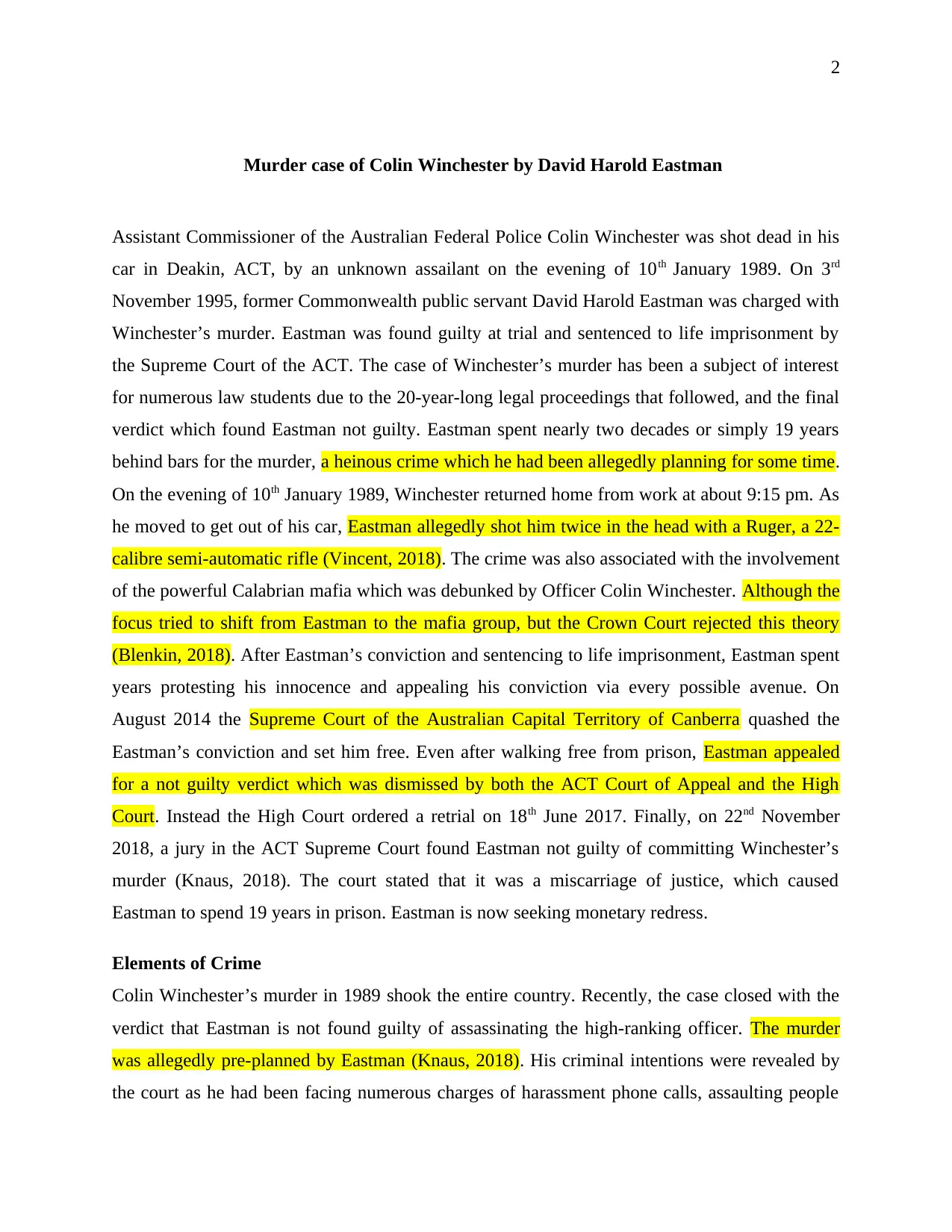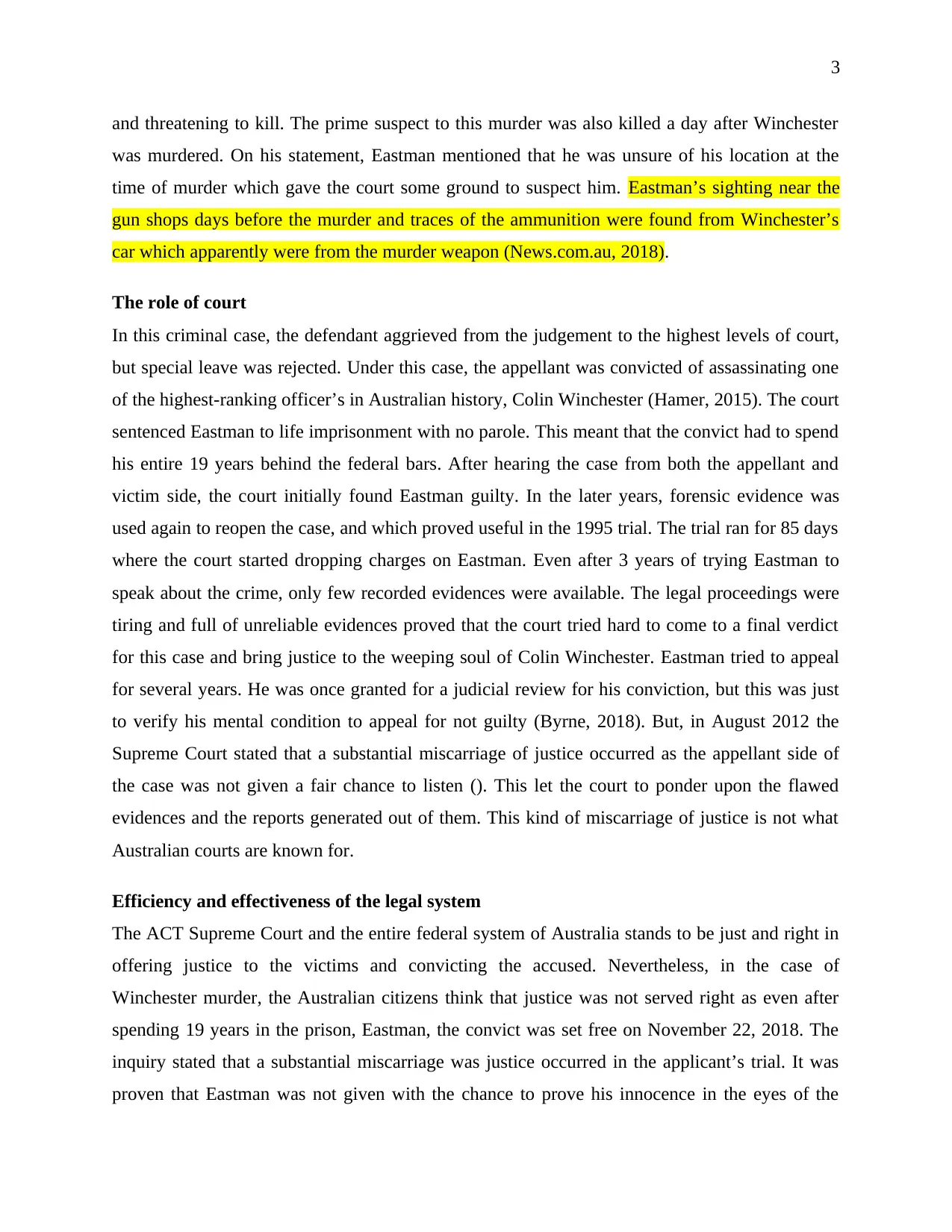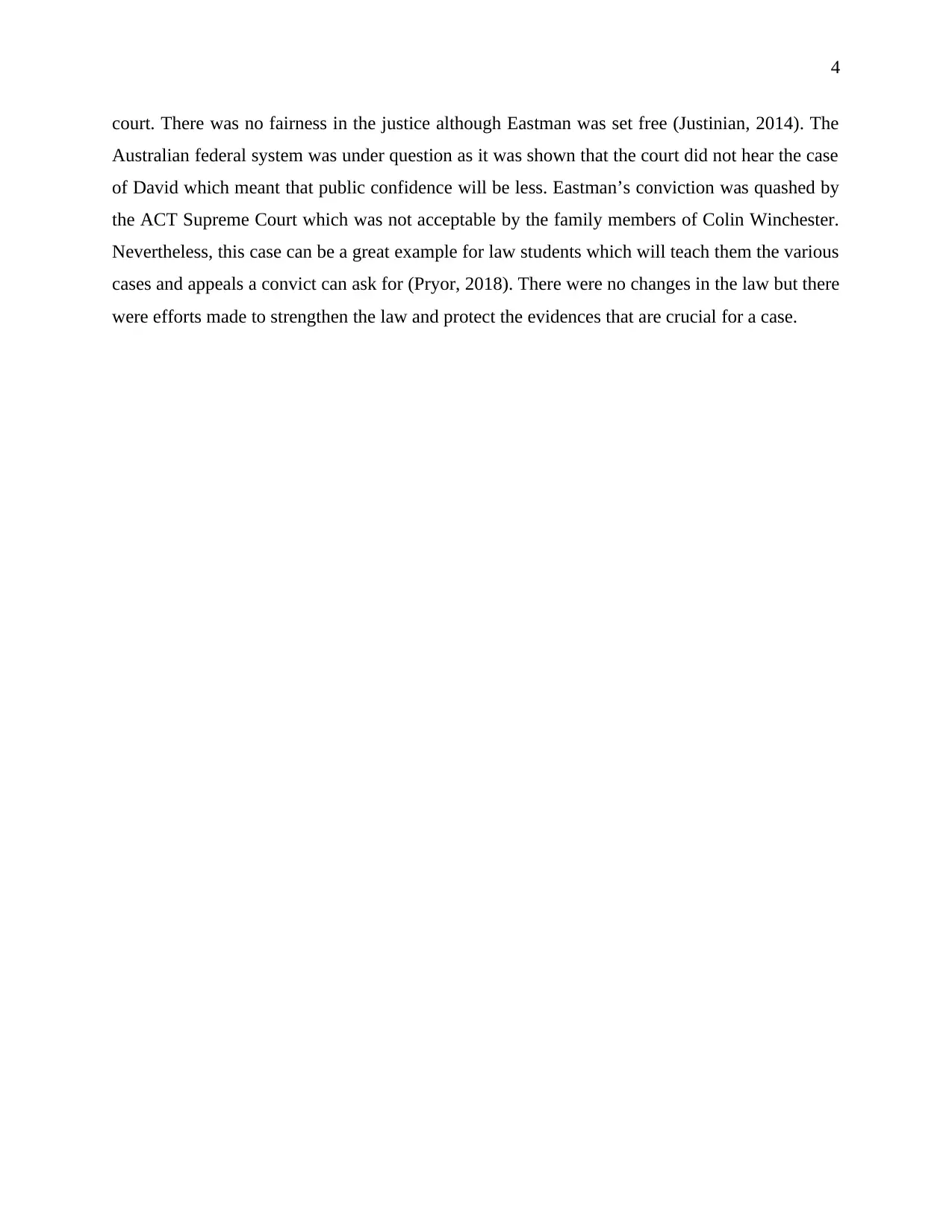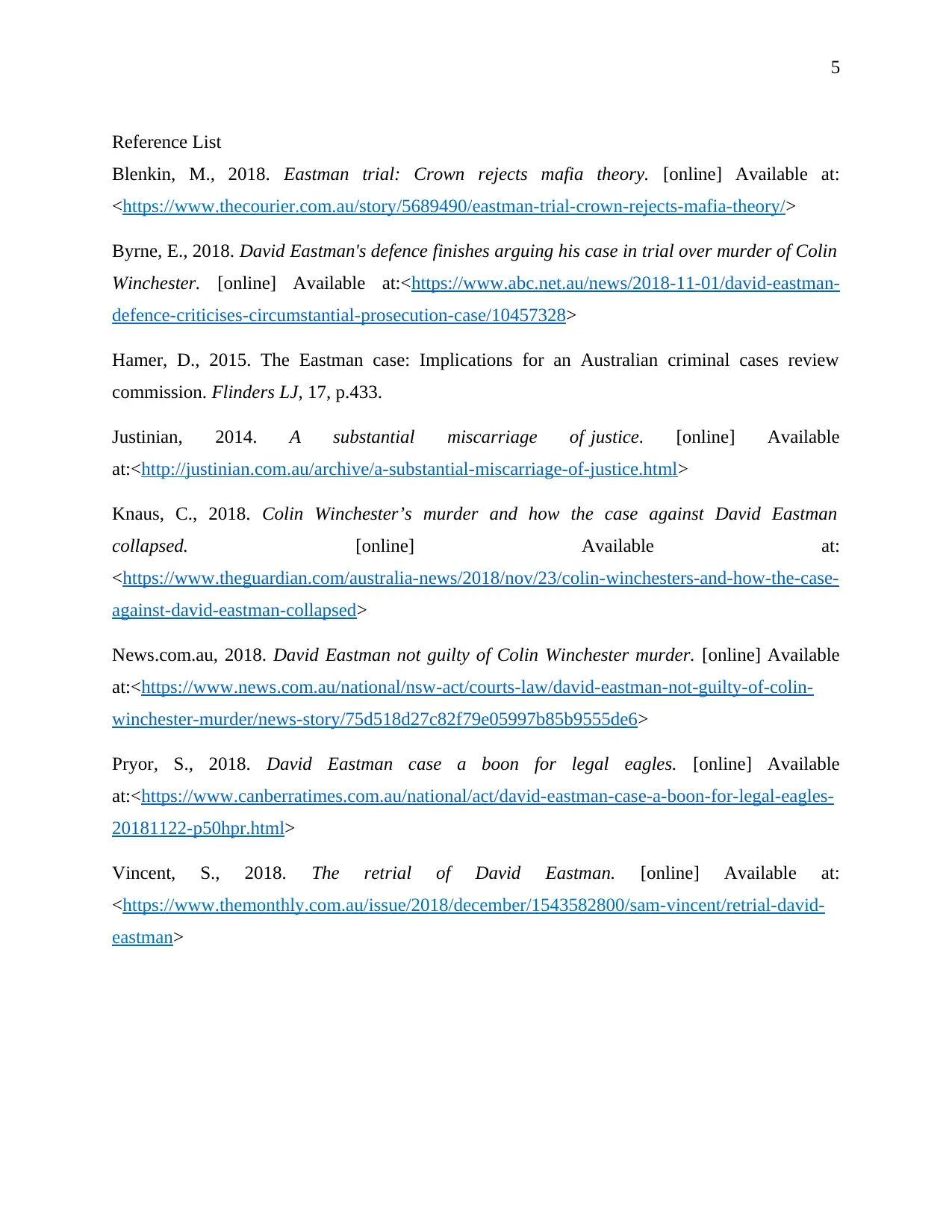Criminal Law Assignment: Analysis of the Winchester vs Eastman Case
VerifiedAdded on 2023/05/31
|6
|1319
|361
Case Study
AI Summary
This case study examines the high-profile murder of Colin Winchester, Assistant Commissioner of the Australian Federal Police, and the subsequent legal proceedings against David Harold Eastman. The assignment details the events of the murder in 1989, Eastman's arrest and conviction, and the lengthy appeals process that spanned nearly two decades. It explores the elements of the crime, the court's role in the trials and appeals, and the arguments presented by both the prosecution and defense. The analysis includes a discussion of the efficiency and effectiveness of the Australian legal system, particularly focusing on the miscarriage of justice that led to Eastman's eventual acquittal. The case study highlights the importance of forensic evidence, legal procedures, and the impact of public opinion on the outcome of the case. The document references key legal precedents and the final verdict, emphasizing the lasting impact of the case on Australian criminal law and the public's perception of the justice system. The case study also analyzes the legal proceedings and the court's decision to find Eastman not guilty, highlighting the complexities of the legal system.

1
Criminal Law
Criminal Law
Paraphrase This Document
Need a fresh take? Get an instant paraphrase of this document with our AI Paraphraser

2
Murder case of Colin Winchester by David Harold Eastman
Assistant Commissioner of the Australian Federal Police Colin Winchester was shot dead in his
car in Deakin, ACT, by an unknown assailant on the evening of 10th January 1989. On 3rd
November 1995, former Commonwealth public servant David Harold Eastman was charged with
Winchester’s murder. Eastman was found guilty at trial and sentenced to life imprisonment by
the Supreme Court of the ACT. The case of Winchester’s murder has been a subject of interest
for numerous law students due to the 20-year-long legal proceedings that followed, and the final
verdict which found Eastman not guilty. Eastman spent nearly two decades or simply 19 years
behind bars for the murder, a heinous crime which he had been allegedly planning for some time.
On the evening of 10th January 1989, Winchester returned home from work at about 9:15 pm. As
he moved to get out of his car, Eastman allegedly shot him twice in the head with a Ruger, a 22-
calibre semi-automatic rifle (Vincent, 2018). The crime was also associated with the involvement
of the powerful Calabrian mafia which was debunked by Officer Colin Winchester. Although the
focus tried to shift from Eastman to the mafia group, but the Crown Court rejected this theory
(Blenkin, 2018). After Eastman’s conviction and sentencing to life imprisonment, Eastman spent
years protesting his innocence and appealing his conviction via every possible avenue. On
August 2014 the Supreme Court of the Australian Capital Territory of Canberra quashed the
Eastman’s conviction and set him free. Even after walking free from prison, Eastman appealed
for a not guilty verdict which was dismissed by both the ACT Court of Appeal and the High
Court. Instead the High Court ordered a retrial on 18th June 2017. Finally, on 22nd November
2018, a jury in the ACT Supreme Court found Eastman not guilty of committing Winchester’s
murder (Knaus, 2018). The court stated that it was a miscarriage of justice, which caused
Eastman to spend 19 years in prison. Eastman is now seeking monetary redress.
Elements of Crime
Colin Winchester’s murder in 1989 shook the entire country. Recently, the case closed with the
verdict that Eastman is not found guilty of assassinating the high-ranking officer. The murder
was allegedly pre-planned by Eastman (Knaus, 2018). His criminal intentions were revealed by
the court as he had been facing numerous charges of harassment phone calls, assaulting people
Murder case of Colin Winchester by David Harold Eastman
Assistant Commissioner of the Australian Federal Police Colin Winchester was shot dead in his
car in Deakin, ACT, by an unknown assailant on the evening of 10th January 1989. On 3rd
November 1995, former Commonwealth public servant David Harold Eastman was charged with
Winchester’s murder. Eastman was found guilty at trial and sentenced to life imprisonment by
the Supreme Court of the ACT. The case of Winchester’s murder has been a subject of interest
for numerous law students due to the 20-year-long legal proceedings that followed, and the final
verdict which found Eastman not guilty. Eastman spent nearly two decades or simply 19 years
behind bars for the murder, a heinous crime which he had been allegedly planning for some time.
On the evening of 10th January 1989, Winchester returned home from work at about 9:15 pm. As
he moved to get out of his car, Eastman allegedly shot him twice in the head with a Ruger, a 22-
calibre semi-automatic rifle (Vincent, 2018). The crime was also associated with the involvement
of the powerful Calabrian mafia which was debunked by Officer Colin Winchester. Although the
focus tried to shift from Eastman to the mafia group, but the Crown Court rejected this theory
(Blenkin, 2018). After Eastman’s conviction and sentencing to life imprisonment, Eastman spent
years protesting his innocence and appealing his conviction via every possible avenue. On
August 2014 the Supreme Court of the Australian Capital Territory of Canberra quashed the
Eastman’s conviction and set him free. Even after walking free from prison, Eastman appealed
for a not guilty verdict which was dismissed by both the ACT Court of Appeal and the High
Court. Instead the High Court ordered a retrial on 18th June 2017. Finally, on 22nd November
2018, a jury in the ACT Supreme Court found Eastman not guilty of committing Winchester’s
murder (Knaus, 2018). The court stated that it was a miscarriage of justice, which caused
Eastman to spend 19 years in prison. Eastman is now seeking monetary redress.
Elements of Crime
Colin Winchester’s murder in 1989 shook the entire country. Recently, the case closed with the
verdict that Eastman is not found guilty of assassinating the high-ranking officer. The murder
was allegedly pre-planned by Eastman (Knaus, 2018). His criminal intentions were revealed by
the court as he had been facing numerous charges of harassment phone calls, assaulting people

3
and threatening to kill. The prime suspect to this murder was also killed a day after Winchester
was murdered. On his statement, Eastman mentioned that he was unsure of his location at the
time of murder which gave the court some ground to suspect him. Eastman’s sighting near the
gun shops days before the murder and traces of the ammunition were found from Winchester’s
car which apparently were from the murder weapon (News.com.au, 2018).
The role of court
In this criminal case, the defendant aggrieved from the judgement to the highest levels of court,
but special leave was rejected. Under this case, the appellant was convicted of assassinating one
of the highest-ranking officer’s in Australian history, Colin Winchester (Hamer, 2015). The court
sentenced Eastman to life imprisonment with no parole. This meant that the convict had to spend
his entire 19 years behind the federal bars. After hearing the case from both the appellant and
victim side, the court initially found Eastman guilty. In the later years, forensic evidence was
used again to reopen the case, and which proved useful in the 1995 trial. The trial ran for 85 days
where the court started dropping charges on Eastman. Even after 3 years of trying Eastman to
speak about the crime, only few recorded evidences were available. The legal proceedings were
tiring and full of unreliable evidences proved that the court tried hard to come to a final verdict
for this case and bring justice to the weeping soul of Colin Winchester. Eastman tried to appeal
for several years. He was once granted for a judicial review for his conviction, but this was just
to verify his mental condition to appeal for not guilty (Byrne, 2018). But, in August 2012 the
Supreme Court stated that a substantial miscarriage of justice occurred as the appellant side of
the case was not given a fair chance to listen (). This let the court to ponder upon the flawed
evidences and the reports generated out of them. This kind of miscarriage of justice is not what
Australian courts are known for.
Efficiency and effectiveness of the legal system
The ACT Supreme Court and the entire federal system of Australia stands to be just and right in
offering justice to the victims and convicting the accused. Nevertheless, in the case of
Winchester murder, the Australian citizens think that justice was not served right as even after
spending 19 years in the prison, Eastman, the convict was set free on November 22, 2018. The
inquiry stated that a substantial miscarriage was justice occurred in the applicant’s trial. It was
proven that Eastman was not given with the chance to prove his innocence in the eyes of the
and threatening to kill. The prime suspect to this murder was also killed a day after Winchester
was murdered. On his statement, Eastman mentioned that he was unsure of his location at the
time of murder which gave the court some ground to suspect him. Eastman’s sighting near the
gun shops days before the murder and traces of the ammunition were found from Winchester’s
car which apparently were from the murder weapon (News.com.au, 2018).
The role of court
In this criminal case, the defendant aggrieved from the judgement to the highest levels of court,
but special leave was rejected. Under this case, the appellant was convicted of assassinating one
of the highest-ranking officer’s in Australian history, Colin Winchester (Hamer, 2015). The court
sentenced Eastman to life imprisonment with no parole. This meant that the convict had to spend
his entire 19 years behind the federal bars. After hearing the case from both the appellant and
victim side, the court initially found Eastman guilty. In the later years, forensic evidence was
used again to reopen the case, and which proved useful in the 1995 trial. The trial ran for 85 days
where the court started dropping charges on Eastman. Even after 3 years of trying Eastman to
speak about the crime, only few recorded evidences were available. The legal proceedings were
tiring and full of unreliable evidences proved that the court tried hard to come to a final verdict
for this case and bring justice to the weeping soul of Colin Winchester. Eastman tried to appeal
for several years. He was once granted for a judicial review for his conviction, but this was just
to verify his mental condition to appeal for not guilty (Byrne, 2018). But, in August 2012 the
Supreme Court stated that a substantial miscarriage of justice occurred as the appellant side of
the case was not given a fair chance to listen (). This let the court to ponder upon the flawed
evidences and the reports generated out of them. This kind of miscarriage of justice is not what
Australian courts are known for.
Efficiency and effectiveness of the legal system
The ACT Supreme Court and the entire federal system of Australia stands to be just and right in
offering justice to the victims and convicting the accused. Nevertheless, in the case of
Winchester murder, the Australian citizens think that justice was not served right as even after
spending 19 years in the prison, Eastman, the convict was set free on November 22, 2018. The
inquiry stated that a substantial miscarriage was justice occurred in the applicant’s trial. It was
proven that Eastman was not given with the chance to prove his innocence in the eyes of the
⊘ This is a preview!⊘
Do you want full access?
Subscribe today to unlock all pages.

Trusted by 1+ million students worldwide

4
court. There was no fairness in the justice although Eastman was set free (Justinian, 2014). The
Australian federal system was under question as it was shown that the court did not hear the case
of David which meant that public confidence will be less. Eastman’s conviction was quashed by
the ACT Supreme Court which was not acceptable by the family members of Colin Winchester.
Nevertheless, this case can be a great example for law students which will teach them the various
cases and appeals a convict can ask for (Pryor, 2018). There were no changes in the law but there
were efforts made to strengthen the law and protect the evidences that are crucial for a case.
court. There was no fairness in the justice although Eastman was set free (Justinian, 2014). The
Australian federal system was under question as it was shown that the court did not hear the case
of David which meant that public confidence will be less. Eastman’s conviction was quashed by
the ACT Supreme Court which was not acceptable by the family members of Colin Winchester.
Nevertheless, this case can be a great example for law students which will teach them the various
cases and appeals a convict can ask for (Pryor, 2018). There were no changes in the law but there
were efforts made to strengthen the law and protect the evidences that are crucial for a case.
Paraphrase This Document
Need a fresh take? Get an instant paraphrase of this document with our AI Paraphraser

5
Reference List
Blenkin, M., 2018. Eastman trial: Crown rejects mafia theory. [online] Available at:
<https://www.thecourier.com.au/story/5689490/eastman-trial-crown-rejects-mafia-theory/>
Byrne, E., 2018. David Eastman's defence finishes arguing his case in trial over murder of Colin
Winchester. [online] Available at:<https://www.abc.net.au/news/2018-11-01/david-eastman-
defence-criticises-circumstantial-prosecution-case/10457328>
Hamer, D., 2015. The Eastman case: Implications for an Australian criminal cases review
commission. Flinders LJ, 17, p.433.
Justinian, 2014. A substantial miscarriage of justice. [online] Available
at:<http://justinian.com.au/archive/a-substantial-miscarriage-of-justice.html>
Knaus, C., 2018. Colin Winchester’s murder and how the case against David Eastman
collapsed. [online] Available at:
<https://www.theguardian.com/australia-news/2018/nov/23/colin-winchesters-and-how-the-case-
against-david-eastman-collapsed>
News.com.au, 2018. David Eastman not guilty of Colin Winchester murder. [online] Available
at:<https://www.news.com.au/national/nsw-act/courts-law/david-eastman-not-guilty-of-colin-
winchester-murder/news-story/75d518d27c82f79e05997b85b9555de6>
Pryor, S., 2018. David Eastman case a boon for legal eagles. [online] Available
at:<https://www.canberratimes.com.au/national/act/david-eastman-case-a-boon-for-legal-eagles-
20181122-p50hpr.html>
Vincent, S., 2018. The retrial of David Eastman. [online] Available at:
<https://www.themonthly.com.au/issue/2018/december/1543582800/sam-vincent/retrial-david-
eastman>
Reference List
Blenkin, M., 2018. Eastman trial: Crown rejects mafia theory. [online] Available at:
<https://www.thecourier.com.au/story/5689490/eastman-trial-crown-rejects-mafia-theory/>
Byrne, E., 2018. David Eastman's defence finishes arguing his case in trial over murder of Colin
Winchester. [online] Available at:<https://www.abc.net.au/news/2018-11-01/david-eastman-
defence-criticises-circumstantial-prosecution-case/10457328>
Hamer, D., 2015. The Eastman case: Implications for an Australian criminal cases review
commission. Flinders LJ, 17, p.433.
Justinian, 2014. A substantial miscarriage of justice. [online] Available
at:<http://justinian.com.au/archive/a-substantial-miscarriage-of-justice.html>
Knaus, C., 2018. Colin Winchester’s murder and how the case against David Eastman
collapsed. [online] Available at:
<https://www.theguardian.com/australia-news/2018/nov/23/colin-winchesters-and-how-the-case-
against-david-eastman-collapsed>
News.com.au, 2018. David Eastman not guilty of Colin Winchester murder. [online] Available
at:<https://www.news.com.au/national/nsw-act/courts-law/david-eastman-not-guilty-of-colin-
winchester-murder/news-story/75d518d27c82f79e05997b85b9555de6>
Pryor, S., 2018. David Eastman case a boon for legal eagles. [online] Available
at:<https://www.canberratimes.com.au/national/act/david-eastman-case-a-boon-for-legal-eagles-
20181122-p50hpr.html>
Vincent, S., 2018. The retrial of David Eastman. [online] Available at:
<https://www.themonthly.com.au/issue/2018/december/1543582800/sam-vincent/retrial-david-
eastman>

6
⊘ This is a preview!⊘
Do you want full access?
Subscribe today to unlock all pages.

Trusted by 1+ million students worldwide
1 out of 6
Your All-in-One AI-Powered Toolkit for Academic Success.
+13062052269
info@desklib.com
Available 24*7 on WhatsApp / Email
![[object Object]](/_next/static/media/star-bottom.7253800d.svg)
Unlock your academic potential
Copyright © 2020–2025 A2Z Services. All Rights Reserved. Developed and managed by ZUCOL.

